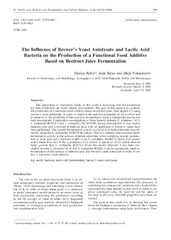The influence of brewer's yeast autolysate and lactic acid bacteria on the production of a functional food additive based on beetroot juice fermentation
Apstrakt
The importance of much greater thanfunctional foodsmuch less than in the world is increasing, and the procedures for their production are under intense development. The goal of this paper is to optimise the production of a functional food additive based on beetroot juice (Beta vulgaris L.) using brewer's yeast autolysate. In order to improve the nutritive properties of the product and to preserve it, the possibility of beetroot juice fermentation using a Lactobacillus species has been investigated. Comparative investigations of three bacteria cultures (L. plantarum A112, L. acidophilus BGSJ15-3 and L. acidophilus NCDO1748) during fermentation in two media, beetroot juice and a mixture of beetroot juice with an autolysate of brewer's yeast, have been performed. The poorest fermentative activity and growth in both substrates was observed using the L. acidophilus NCDO1748 culture. The two cultures demonstrated better fermentative activity in the mixture of tested substrates, while acidify...ing activity (production of lactic acid and a decrease in pH) of the L. acidophilus BGSJ15-3 culture was considerably better than that of the L. plantarum A112 culture. L. plantarum A112 culture showed better growth than L. acidophilus BGSJ15-3. From the results obtained, it has been concluded that the L. plantarum A112 and L. acidophilus BGSJ15-3 can be successfully used for fermentation of the mixture of beetroot juice and brewer's yeast autolysate in order to obtain a functional food additive.
Ključne reči:
beetroot / lactic acid fermentation / brewer's yeast autolysateIzvor:
Food Technology and Biotechnology, 2004, 42, 2, 109-113Izdavač:
- University of Zagreb
Institucija/grupa
Tehnološko-metalurški fakultetTY - JOUR AU - Rakin, Marica AU - Baras, Josip AU - Vukašinović-Sekulić, Maja PY - 2004 UR - http://TechnoRep.tmf.bg.ac.rs/handle/123456789/598 AB - The importance of much greater thanfunctional foodsmuch less than in the world is increasing, and the procedures for their production are under intense development. The goal of this paper is to optimise the production of a functional food additive based on beetroot juice (Beta vulgaris L.) using brewer's yeast autolysate. In order to improve the nutritive properties of the product and to preserve it, the possibility of beetroot juice fermentation using a Lactobacillus species has been investigated. Comparative investigations of three bacteria cultures (L. plantarum A112, L. acidophilus BGSJ15-3 and L. acidophilus NCDO1748) during fermentation in two media, beetroot juice and a mixture of beetroot juice with an autolysate of brewer's yeast, have been performed. The poorest fermentative activity and growth in both substrates was observed using the L. acidophilus NCDO1748 culture. The two cultures demonstrated better fermentative activity in the mixture of tested substrates, while acidifying activity (production of lactic acid and a decrease in pH) of the L. acidophilus BGSJ15-3 culture was considerably better than that of the L. plantarum A112 culture. L. plantarum A112 culture showed better growth than L. acidophilus BGSJ15-3. From the results obtained, it has been concluded that the L. plantarum A112 and L. acidophilus BGSJ15-3 can be successfully used for fermentation of the mixture of beetroot juice and brewer's yeast autolysate in order to obtain a functional food additive. PB - University of Zagreb T2 - Food Technology and Biotechnology T1 - The influence of brewer's yeast autolysate and lactic acid bacteria on the production of a functional food additive based on beetroot juice fermentation EP - 113 IS - 2 SP - 109 VL - 42 UR - https://hdl.handle.net/21.15107/rcub_technorep_598 ER -
@article{
author = "Rakin, Marica and Baras, Josip and Vukašinović-Sekulić, Maja",
year = "2004",
abstract = "The importance of much greater thanfunctional foodsmuch less than in the world is increasing, and the procedures for their production are under intense development. The goal of this paper is to optimise the production of a functional food additive based on beetroot juice (Beta vulgaris L.) using brewer's yeast autolysate. In order to improve the nutritive properties of the product and to preserve it, the possibility of beetroot juice fermentation using a Lactobacillus species has been investigated. Comparative investigations of three bacteria cultures (L. plantarum A112, L. acidophilus BGSJ15-3 and L. acidophilus NCDO1748) during fermentation in two media, beetroot juice and a mixture of beetroot juice with an autolysate of brewer's yeast, have been performed. The poorest fermentative activity and growth in both substrates was observed using the L. acidophilus NCDO1748 culture. The two cultures demonstrated better fermentative activity in the mixture of tested substrates, while acidifying activity (production of lactic acid and a decrease in pH) of the L. acidophilus BGSJ15-3 culture was considerably better than that of the L. plantarum A112 culture. L. plantarum A112 culture showed better growth than L. acidophilus BGSJ15-3. From the results obtained, it has been concluded that the L. plantarum A112 and L. acidophilus BGSJ15-3 can be successfully used for fermentation of the mixture of beetroot juice and brewer's yeast autolysate in order to obtain a functional food additive.",
publisher = "University of Zagreb",
journal = "Food Technology and Biotechnology",
title = "The influence of brewer's yeast autolysate and lactic acid bacteria on the production of a functional food additive based on beetroot juice fermentation",
pages = "113-109",
number = "2",
volume = "42",
url = "https://hdl.handle.net/21.15107/rcub_technorep_598"
}
Rakin, M., Baras, J.,& Vukašinović-Sekulić, M.. (2004). The influence of brewer's yeast autolysate and lactic acid bacteria on the production of a functional food additive based on beetroot juice fermentation. in Food Technology and Biotechnology University of Zagreb., 42(2), 109-113. https://hdl.handle.net/21.15107/rcub_technorep_598
Rakin M, Baras J, Vukašinović-Sekulić M. The influence of brewer's yeast autolysate and lactic acid bacteria on the production of a functional food additive based on beetroot juice fermentation. in Food Technology and Biotechnology. 2004;42(2):109-113. https://hdl.handle.net/21.15107/rcub_technorep_598 .
Rakin, Marica, Baras, Josip, Vukašinović-Sekulić, Maja, "The influence of brewer's yeast autolysate and lactic acid bacteria on the production of a functional food additive based on beetroot juice fermentation" in Food Technology and Biotechnology, 42, no. 2 (2004):109-113, https://hdl.handle.net/21.15107/rcub_technorep_598 .



